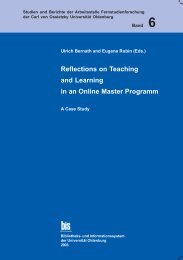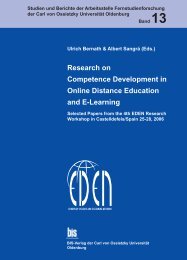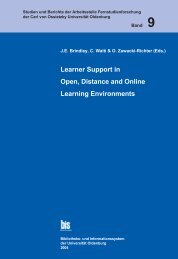Distance Education in Transition - Master of Distance Education ...
Distance Education in Transition - Master of Distance Education ...
Distance Education in Transition - Master of Distance Education ...
Create successful ePaper yourself
Turn your PDF publications into a flip-book with our unique Google optimized e-Paper software.
Visions <strong>of</strong> Autonomous Learn<strong>in</strong>g<br />
about a hundred years. I cannot go <strong>in</strong>to all the details here and I will limit myself to<br />
mention<strong>in</strong>g just some <strong>of</strong> them:<br />
� John Dewey and his concept <strong>of</strong> “self-activity” (1916, p. 353). He ma<strong>in</strong>ta<strong>in</strong>ed that<br />
“Children like grown persons, require a judicious amount <strong>of</strong> be<strong>in</strong>g let alone.” –<br />
“Only by a pupil’s own observations, reflections, fram<strong>in</strong>g and test<strong>in</strong>g <strong>of</strong> suggestions<br />
can what he already knows be amplified and rectified.” (1952, p. 553).<br />
� Carlton W. Washburne and his “W<strong>in</strong>etka Plan” which put the learner beyond the<br />
cont<strong>in</strong>ual reach <strong>of</strong> the teacher ( cf. Scheibe 1969, p. 309)<br />
� Maria Montessori and her “pedagogical material” which enabled children to learn<br />
<strong>in</strong>dividually without the assistance <strong>of</strong> a teacher (cf. Montessori, 1913).<br />
� Malcolm S. Knowles and his <strong>in</strong>fluential concept <strong>of</strong> “self-directed learn<strong>in</strong>g”.<br />
� Charles A. Wedemeyer and his concept <strong>of</strong> <strong>in</strong>dependent learn<strong>in</strong>g (cf. Wedemeyer,<br />
1981)<br />
� Hugo Gaudig, a German school reformer, who advocated “free mental activity” <strong>of</strong><br />
students (cf. Gaudig, 1922).<br />
� Otto Scheibner, another school reformer, who <strong>in</strong>terpreted learn<strong>in</strong>g as an <strong>in</strong>dividual<br />
work<strong>in</strong>g process and provided a general plan <strong>of</strong> <strong>in</strong>dependent learn<strong>in</strong>g consist<strong>in</strong>g <strong>of</strong><br />
five formal steps (cf. Scheibner, 1930).<br />
Some <strong>of</strong> these reformers tried to change the learn<strong>in</strong>g behaviour not <strong>of</strong> adults, but <strong>of</strong><br />
school children. This is an important aspect.<br />
Helmut Felix Friedrich, the educational psychologist, characterised the general situation<br />
<strong>in</strong> this way:<br />
“Whereas the debates (sc. on self-controlled learn<strong>in</strong>g) 10 to 15 years ago were to<br />
a great extent <strong>in</strong>ter-discipl<strong>in</strong>ary discussions <strong>in</strong> which educational scientists and<br />
psychologists announced: you may use self-controlled learn<strong>in</strong>g, today they say:<br />
you must use self-controlled learn<strong>in</strong>g.” (1996, p. 42).<br />
Characteris<strong>in</strong>g the situation today I would add that we should re-double and concentrate<br />
our efforts on establish<strong>in</strong>g and develop<strong>in</strong>g autonomous learn<strong>in</strong>g.<br />
The extent to which the vision <strong>of</strong> autonomous learn<strong>in</strong>g affected even the <strong>of</strong>ficial<br />
American national education policy can be seen from the follow<strong>in</strong>g guidel<strong>in</strong>e issued by<br />
John W. Gardner, a former Secretary <strong>of</strong> Health, <strong>Education</strong> and Welfare:<br />
"The ultimate goal <strong>of</strong> the educational system is to shift to the <strong>in</strong>dividual the<br />
burden <strong>of</strong> pursu<strong>in</strong>g his own education.” (Zimmerman & Schunk, 1989, p. V).<br />
6. Visions <strong>of</strong> Pedagogical Innovation<br />
6.1. First and Second-generation Onl<strong>in</strong>e Learn<strong>in</strong>g<br />
We have all experienced “first generation” onl<strong>in</strong>e learn<strong>in</strong>g. We learnt that the most<br />
important impediment to the development <strong>of</strong> autonomous learn<strong>in</strong>g is the widespread habit <strong>of</strong><br />
replicat<strong>in</strong>g traditional formats <strong>of</strong> expository teach<strong>in</strong>g, such as lectures and tak<strong>in</strong>g notes.<br />
Rolf Schulmeister (2001, p. 225) analysed a great number <strong>of</strong> learn<strong>in</strong>g projects at virtual<br />
universities <strong>in</strong> many countries. His f<strong>in</strong>d<strong>in</strong>gs are as follows:<br />
222





